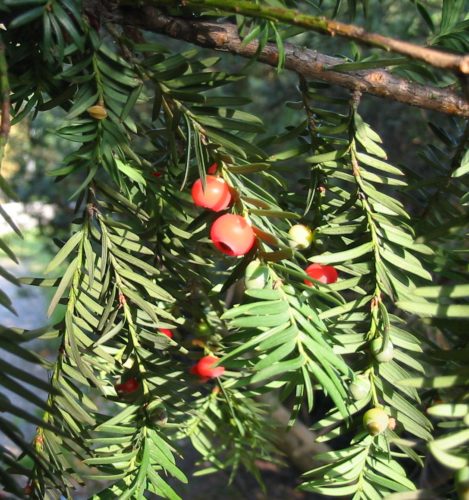Yew is a tall, slow-growing conifer belonging to the yew fmailie.
Also known as:
European yew (Taxus baccata)
You are viewing the mobile-adapted version of the page.
The one for tablets, laptop and desktop also provides general information, such as origin, toxicity and cultivation.
- All parts of the yew are poisonous to humans and animals except for the skirts of the berries. The seeds are very poisonous. Birds can eat the berries because the bird’s stomach does not break down the seed coat; the stomachs of humans and animals do. Just a handful of needles has fatal consequences.
Yew (Taxus baccata) is a tall-rising, slow-growing conifer belonging to the yew family (Taxaceae). The yew is native to Europe. A yew can get very old and over time (centuries) grow into a tree twenty meters tall with a trunk circumference of five meters. Yew is evergreen and hardy.
The yew tree can often be found in church graveyards. Yew grows best in well-drained soil; they do not like wet feet. Yew can be planted in both full sun and (semi-)shade.
A yew hedge prunes (“shears”) well with hedge clippers: twice a year keeps the hedge in shape. May and September are the best months for pruning. Always prune so that the top is narrower than the bottom: that way the bottom of the hedge does not end up in its own (rain) shade and become top-heavy. Frequent pruning removes many nutrients from the soil; regular (spring) fertilizing keeps the hedge healthy.
Yew also lends itself to topiary pruning. Sometimes pruned back to the bare wood; unlike other conifers, the yew sprouts again in those bare spots.
Do not plant yew such that livestock (horse) can eat from it; yew contains the highly toxic taxine, an alkaloid.
Bugs
The edges of the needles are gnawed on: Vine weevil (Otiorhynchus sulcatus). The larva of this beetle attacks roots and young bark.
Branches of the taxus turn brown: Cypress aphid (Cinara cupressi).
Fungi & diseases
If the yew is in wet soil, root rot is easily caused by the fungus Phytophthora.
In some places the yew yellows, after which the branches wither and the infection gradually spreads through the yew: branch death caused by the fungi Cedar leaf blight (Didymascella thujina) and needle blight (Kabatina juniperi).
Other
Brown dots on the ends of branches: blunt pruning tools, cutting the green raggedly. Or the pruning took place in late fall or winter, causing the pruned foliage to die due to cold.

